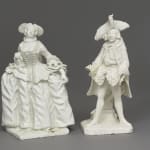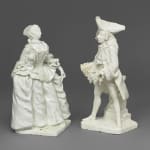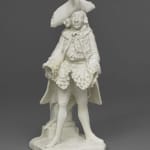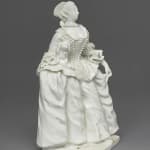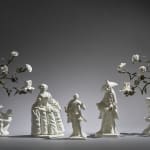




An Extremely Important and Very Rare Pair of Bow White Figures of Kitty Clive and Henry Woodward, Circa 1750-1755
Further images
An Extremely Important and Very Rare Pair of Bow White Figures of Kitty Clive and Henry Woodward. The actress Kitty Clive and the actor Henry Woodward are modelled in the role of Mrs Riot and The Fine Gentleman in David Garrick’s farce ‘Lethe’, where these roles were added by the playwright David Garrick for Clive and Woodward in 1749. Kitty Clive wears a lace mob-cap and laced edged jacket over an incised bodice and broad crinoline dress. She lifts her skirt with her left hand, sleeves ruffled, while her dog is tucked beneath her right arm, standing on a square base, left shoe with ribbon bow peeking out from beneath her voluminous skirt. Henry Woodward is modelled in tasselled jacket and buttoned waistcoat, incised with scrolls, wearing a tricorn hat and tight breeches, his sword behind his leg, standing before a ruined pillar on an incised diaper-patter square base.
Further Details: The play Lethe opened in 1740 at Drury Lane but Kitty Clive did not join the cast until 1749. As Peter Bradshaw writes ‘The scenario relates to fashionable characters from contemporary London who pour out their woes to Old Aesop as they cross the river Styx, hoping thereby to gain access to the waters of Lethe and obtain oblivion’. The character of Mrs Riot is described by the playwright David Garrick, who wrote: ‘She lies abed all morning, rattles about all day, sits up all night; she goes everywhere and sees everything; she knows everybody and loves nobody; ridicules her friends, coquets with her lovers, sets ‘em together by their ears, tells fibs, makes mischief, buys china, cheats at cards, keeps a pet dog and hates parsons…’
Mrs Clive (1711-1785) was born in Kilkenny and made her theatre debut at Drury Lane in 1728. In her later years, she befriended Horace Walpole and lived in a cottage on his Strawberry Hill estate. In describing her, he writes for her epitaph: ‘Here lived the laughter-loving dame, // A matchless actress, Clive her name. // The Comic Muse with her retired // And shed a tear when she expir’d’.
Of Henry Woodward’s companion character, Garrick wrote: ‘Faith, my existence is merely supported by amusements. I dress, visit, study, taste, write sonnets; by birth, travel, education and natural abilities I am entitled to lead the fashion. I am the principal connoisseur at all auctions, the chief arbiter at assemblies, professional critic at the theatre and a Fine Gentleman everywhere…’
Kitty Clive is modelled after a mezzotint by Charles Mosley after a drawing by Thomas Worlidge published in 1750. Henry Woodward is modelled after an undated mezzotint by James McArdell after a drawing by Francis Hayman.
These figures are the earliest full-length portrait figures in English porcelain.
A similar pair can be found in the British Museum, London (1887,0307,I.5 & 1887,0307,I.6), a pair in the Holborne Museum, Bath (P23 & P443), a pair in the J. W. L. Glaisher Collection bequeathed to the Fitzwilliam Museum, Cambridge (C.3026B-1928 & EC.3-1938). See a pair in the National Victoria Gallery, Australia (3804A.1-2-D3). See a pair as gifts of Irwin Untermyer in The Metropolitan Museum of Art, New York (64.101.691 & 64.101.690), a pair in the Jessie and Sigmund Katz Collection, Museum of Fine Arts, Boston (1988.572 & 57.757), and a pair in the Folger Shakespeare Library, Washington, DC (ART 241006 & ART 241007.1).
Provenance
Private American CollectionLiterature
A similar pair can be found in the British Museum, London (1887,0307,I.5 & 1887,0307,I.6), a pair in the Holborne Museum, Bath (P23 & P443), a pair in the J. W. L. Glaisher Collection bequeathed to the Fitzwilliam Museum, Cambridge (C.3026B-1928 & EC.3-1938). See a pair in the National Victoria Gallery, Australia (3804A.1-2-D3). See a pair as gifts of Irwin Untermyer in The Metropolitan Museum of Art, New York (64.101.691 & 64.101.690), a pair in the Jessie and Sigmund Katz Collection, Museum of Fine Arts, Boston (1988.572 & 57.757), and a pair in the Folger Shakespeare Library, Washington, DC (ART 241006 & ART 241007.1).Join our mailing list
* denotes required fields
We will process the personal data you have supplied in accordance with our privacy policy (available on request). You can unsubscribe or change your preferences at any time by clicking the link in our emails.
